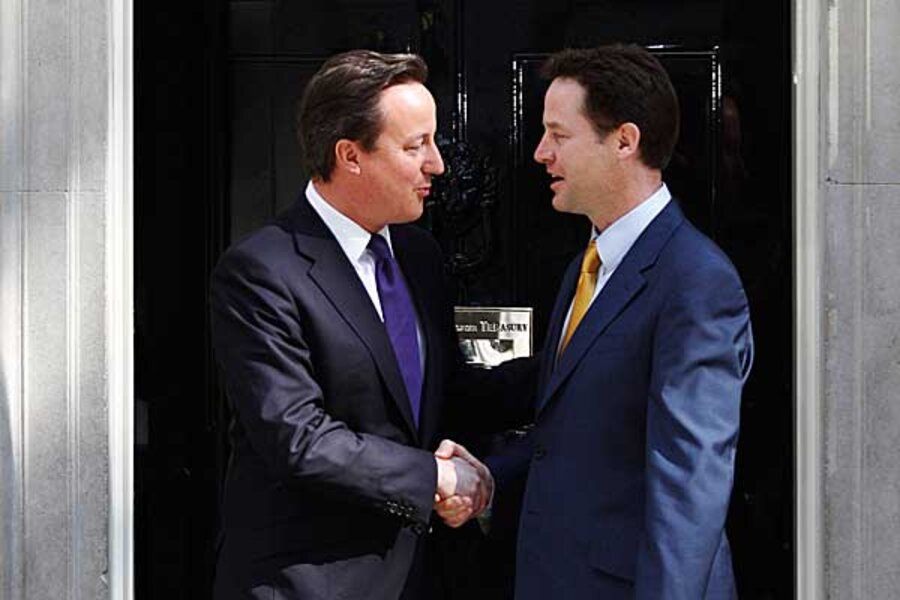Can David Cameron keep new UK coalition government together?
Loading...
| London
Facing the challenge of cutting Britain’s towering deficit, the UK’s first coalition government since World War II began the work of ruling the country today as Britons wondered: ‘how long will it last?’
Days of hard bargaining since last Thursday’s inconclusive election produced a pact between the centrist Liberal Democrats and the larger Conservative Party in which both sides made sacrifices, paving the way for David Cameron to become the first Tory prime minister since 1997.
But while the two partners make unlikely political bedfellows in many policy areas – immigration and European integration are two key differences – what may keep the coalition together for years to come is a joint desire to only face the voting public again after the pain has subsided from efforts to tackle Britain's ballooning debt. This year's budget deficit is projected at £163 billion ($240 billion), worth about 11 percent of the UK's gross domestic product.
“I think that either side, and the Liberal Democrats in particular, will want to hold on to power for as long as possible,” says Martin Laffin, professor of Public Policy and Management at the University of Durham’s business school. “That’s because as the popularity of the government plummets, the last thing they will want is to be exposed to an electorate. When the economic upturn comes they can say: look what we achieved.”
"This is a government that will last," LibDem party leader Nick Clegg said after his first press conference with Prime Minister Cameron.
If divisions do not emerge, it is likely to last five years on the basis of plans by the coalition to create fixed-term parliaments, meaning that next general election would not take place until May 2015.
Tory concessions
Some observers have expressed surprise at the concessions the junior coalition partner appears to have extracted from the Conservatives. Among other things, the Conservatives agreed to hold a referendum on the Liberal’s much cherished dream of reforming Britain’s electoral system. The Liberals believe a shift to proportional representation system from the UK's current winner-takes-all electoral districts will give them a stronger voice in government. In the general election, the party won 23 percent of the national vote, but just under 9 percent of the seats in parliament.
Other concessions reportedly include plans to transform parliament’s House of Lords into a second chamber elected nationally using the proportional representation system of voting, as well as measures to increase the income tax threshold to £10,000.
A significant number of Liberal Democrats are also expected to take seats at the cabinet table. Mr. Clegg will become deputy prime minister, while a role overseeing the reform of the banking system is to be given to Vince Cable, an economist whose popularity rose after being credited for warning of the global economic crisis.
The Conservatives, meanwhile, appear to have convinced the Liberals to accept the need for major cuts in government spending much sooner than the smaller party had wanted. Tory manifesto promises have also been upheld on capping immigration from non-European Union states, reforming welfare, and rolling out an education program that will allow parents to set up their own charter schools.
UK coalition history
The arrangement has sent those looking for hints about the coalition’s likely lifespan scurrying to the history books. Formal coalitions at Westminster (home of the British Parliament) are extremely rare, aside from the two World Wars, when the main governments of national unity were formed.
In peacetime, they have occurred as a result of party splits, such as the 1918-1922 government of Britain’s last liberal prime minister, Lloyd George. Following a Liberal split, he ruled with the support of Conservatives, who dominated the coalition.
That coalition is the closest analogy to today’s partnership, according to Andrew Roberts, a prominent conservative historian, and to a lesser extent the depression era "national government" of the 1930s, which included members of all the main parties.
“An awful lot can be drawn from past experiences of coalitions,” says Mr. Roberts. “Firstly, they are only worthwhile in a crisis and obviously at the moment we are in a massive crisis in regard to the deficit – but once the crisis hopefully eases after the medicine has been taken, then coalitions quickly fall apart.”
Name-checking a famous 19th century Tory prime minister, he adds: “As [Benjamin] Disraeli says: ‘England does not love coalitions.’ ... The Westminster system is not designed for them, but in the course of an actual major crisis, such as the financial one we have at the moment, they are pretty popular.”
He suggests that the present coalition should learn an important lesson from its 1918-1922 antecedent, which is how disconnects can easily arise between party leaders and the rank and file. Lloyd George’s government fell because of discontent within the Tory Party, even though its leader at the time was in favor of continuing.
“So what Cameron must look for, in particular, is irritating backbench Liberals, and Clegg with the Conservatives,” he adds.
Related:





